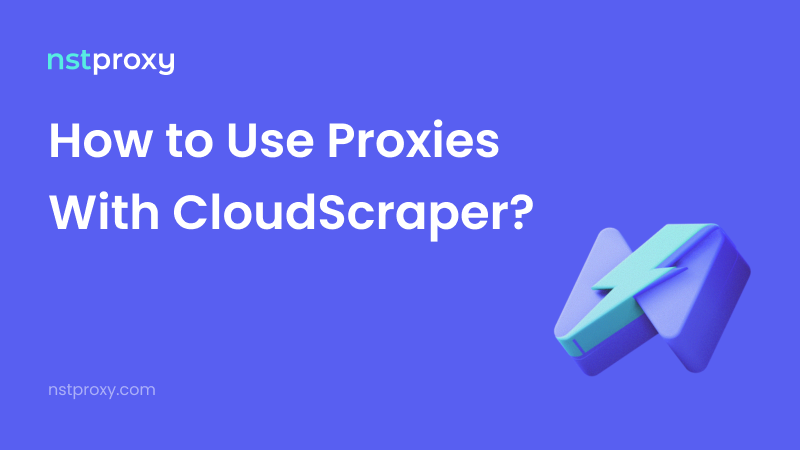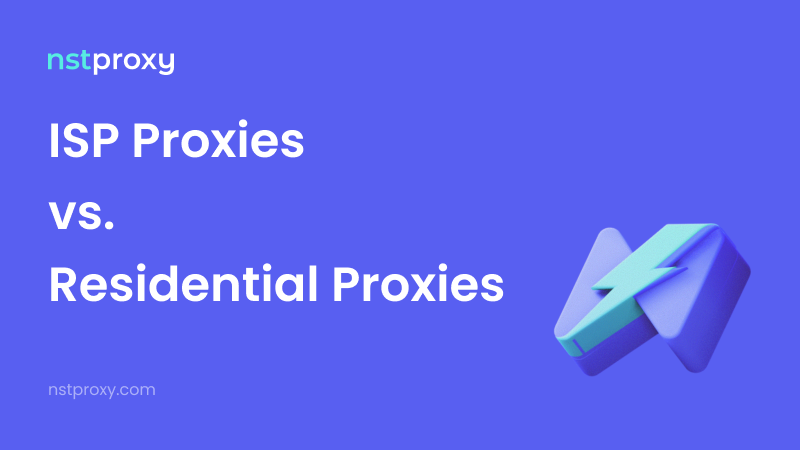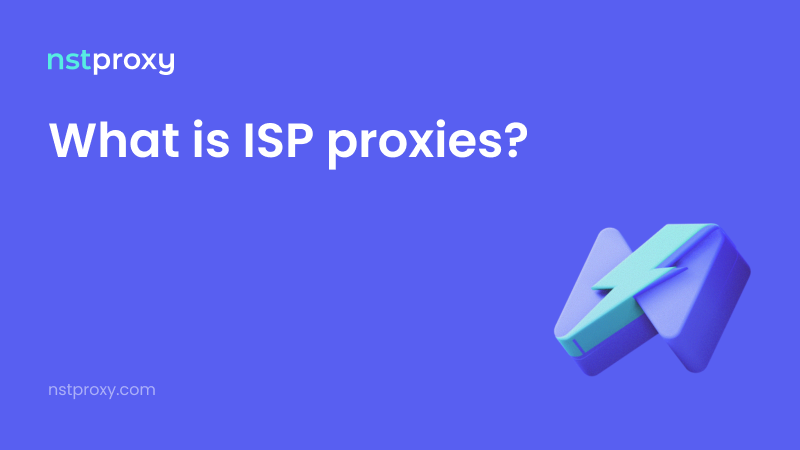Introduction
In the realm of web data scraping, advanced anti-scraping mechanisms like Cloudflare pose common challenges. CloudScraper, a powerful Python module, is designed to circumvent these defenses. However, CloudScraper alone is often insufficient to tackle complex anti-scraping strategies. Combining it with high-quality proxy services, especially providers like Nstproxy with vast IP pools and intelligent rotation features, is essential for achieving efficient and stable data collection. This article will delve into the synergy between CloudScraper and proxies, detailing how to leverage Nstproxy's residential, ISP, and datacenter proxies to ensure uninterrupted scraping tasks, particularly in high-demand scenarios like AI data collection.
What is CloudScraper?
CloudScraper is a Python module specifically designed to bypass Cloudflare's anti-bot page (commonly known as "I'm Under Attack Mode" or IUAM). Built upon the popular Requests library, it simulates browser behavior, passing JavaScript challenges and other checks to trick Cloudflare into believing requests originate from a real user. When target websites are protected by Cloudflare, CloudScraper is a vital tool for web scraping. However, Cloudflare's anti-scraping mechanisms are constantly updated, necessitating regular maintenance and upgrades for CloudScraper to remain effective.
Why Does CloudScraper Need Proxies?
Cloudflare rigorously monitors request frequencies from the same IP address. If too many requests originate from a single IP, even with CloudScraper, your IP address may be temporarily or permanently blocked. Proxy servers are central to resolving this issue. Proxies act as intermediaries between your scraper and the target website, replacing your real IP address with that of the proxy server. This means that even if a proxy IP is blocked, you can quickly switch to a new one, ensuring uninterrupted scraping tasks.
By integrating proxies, CloudScraper's advantages are maximized:
- Enhanced Anonymity and Security: Routing requests through a proxy conceals your true identity, reducing the risk of tracking and identification.
- Bypassing Blocks and Interruptions: Proxies enable dynamic IP rotation, effectively circumventing website rate limits and IP bans, ensuring the continuity of data collection.
Nstproxy offers globally leading proxy services, with high-quality residential, ISP, and datacenter proxies that provide stable and reliable IP support for CloudScraper, helping you effortlessly overcome various anti-scraping challenges.
Nstproxy Empowers CloudScraper: Step-by-Step Proxy Configuration
Step One: Install CloudScraper
First, ensure CloudScraper is installed in your Python environment. You can install or update it via pip:
pip install -U cloudscraperStep Two: Initialize CloudScraper
Import the CloudScraper library and create an instance. This instance behaves similarly to the Session object in the Requests library:
import cloudscraper
scraper = cloudscraper.create_scraper()Step Three: Integrate Nstproxy Proxies
CloudScraper is built on Requests, so proxy integration is the same as with the Requests library. You need to define a proxy dictionary and pass it to the get() or post() method. Nstproxy offers various proxy types; here's an example using an authenticated residential proxy:
import cloudscraper
# Replace with your Nstproxy authentication information
NSTPROXY_USERNAME = "your_nstproxy_username"
NSTPROXY_PASSWORD = "your_nstproxy_password"
# Nstproxy residential proxy entry point (may vary based on your plan)
# Example: http://<username>:<password>@gate.nstproxy.io:port
proxy_url = f"http://{NSTPROXY_USERNAME}:{NSTPROXY_PASSWORD}@gate.nstproxy.io:24125" # Assuming gate.nstproxy.io:24125 as entry
proxies = {
"http": proxy_url,
"https": proxy_url
}
scraper = cloudscraper.create_scraper()
# Send request through Nstproxy proxy
target_url = "https://httpbin.io/ip" # Target URL for IP testing
response = scraper.get(target_url, proxies=proxies)
print(response.text)If configured correctly, you will see the IP address of the Nstproxy server, not your local real IP. Nstproxy's proxy services support HTTP, HTTPS, and SOCKS5 protocols, ensuring seamless integration with CloudScraper.
Implementing Smart IP Rotation: The Nstproxy Advantage
A single proxy IP still carries the risk of being blocked. Smart IP rotation is crucial for maintaining long-term stable scraping. Nstproxy's proxy pool boasts tens of millions of real residential IPs and supports various rotation strategies, ensuring your scraping requests use different IPs each time, significantly reducing the likelihood of detection by target websites.
Nstproxy's smart IP rotation mechanism can be configured to your needs:
- Request-level Rotation: A new IP is assigned for each request, suitable for scenarios requiring extremely high anonymity.
- Session-level Rotation: The same IP is maintained for a certain period (e.g., 5 or 10 minutes), suitable for scraping tasks that require maintaining session state.
- Geo-targeting: You can specify IPs from particular countries, regions, or even cities, ensuring the geographical accuracy of your data scraping.
Here's a CloudScraper example demonstrating IP rotation with Nstproxy:
import cloudscraper
import random
# Replace with your Nstproxy authentication information
NSTPROXY_USERNAME = "your_nstproxy_username"
NSTPROXY_PASSWORD = "your_nstproxy_password"
# Nstproxy's dynamic residential proxy entry point, automatically assigns a new IP for each request
# Nstproxy typically provides a smart entry point that handles IP rotation automatically
# Assuming Nstproxy provides a dynamic IP entry like this
dynamic_proxy_url = f"http://{NSTPROXY_USERNAME}:{NSTPROXY_PASSWORD}@gate.nstproxy.io:24125"
scraper = cloudscraper.create_scraper()
# Use Nstproxy's dynamic proxy entry, automatically rotating IPs for each request
target_url = "https://httpbin.io/ip"
response = scraper.get(target_url, proxies={
"http": dynamic_proxy_url,
"https": dynamic_proxy_url
})
print(response.text)
# If more granular control is needed, e.g., from a predefined IP list (Nstproxy usually provides dynamic entries directly, no manual list maintenance needed)
# proxy_list = [
# f"http://{NSTPROXY_USERNAME}:{NSTPROXY_PASSWORD}@gate.nstproxy.io:port1",
# f"http://{NSTPROXY_USERNAME}:{NSTPROXY_PASSWORD}@gate.nstproxy.io:port2",
# # ... more IPs provided by Nstproxy
# ]
# random_proxy = random.choice(proxy_list)
# response = scraper.get(target_url, proxies={"http": random_proxy, "https": random_proxy})
# print(response.text)Nstproxy's smart rotation mechanism greatly simplifies proxy management, allowing developers to focus on scraping logic without worrying about IP bans.
Nstproxy: The Ultimate Tool for Complex Anti-Scraping and AI Data Collection
In today's complex network environment, merely bypassing Cloudflare is not enough. Many websites employ multi-layered anti-scraping strategies, including browser fingerprinting, behavioral analysis, and CAPTCHA verification. Nstproxy, with its excellent proxy network and technical advantages, provides comprehensive solutions for these challenges:
- Massive Pool of Real Residential IPs: Nstproxy boasts tens of millions of real residential IPs, covering over 200 countries and regions worldwide, ensuring the richness and diversity of IP resources. This makes your requests harder to identify as automated traffic, especially suitable for AI data collection tasks requiring high anonymity.
- High-Performance ISP Proxies: Combining the speed of datacenter proxies with the anonymity of residential proxies, ISP proxies are an ideal choice for scenarios requiring high-speed, stable connections while maintaining high anonymity, such as real-time news monitoring or financial data scraping.
- Flexible Billing Models: Nstproxy offers various billing options, including by traffic, by IP count, or by bandwidth, to meet the needs of different project scales and budgets, avoiding resource waste.
- IPv6 Proxy Support: With the increasing adoption of IPv6, Nstproxy provides IPv6 proxies, helping users access websites that only support IPv6 or are IPv6-friendly, offering a broader data source for AI training.
- Optimization for AI Scenarios: Nstproxy's proxy services are optimized to provide stable, low-latency connections, meeting the demand for large-scale, high-quality data for AI model training, accelerating the development process of AI projects.
Practical Cases: Nstproxy in CloudScraper Applications
Scenario One: Competitor Price Monitoring Bypassing Cloudflare Protection
An e-commerce company needs to monitor price changes on competitor websites, which are generally protected by Cloudflare. By combining CloudScraper with Nstproxy's dynamic residential proxies, the company can:
- Continuous and Stable Access: Nstproxy's dynamic residential proxies ensure that each request uses a new real IP, effectively bypassing Cloudflare's IP bans, enabling 24/7 uninterrupted monitoring.
- Simulate Real Users: Residential IPs simulate real user visits, reducing the risk of being identified as a bot and obtaining accurate price data.
- Save Development Costs: Nstproxy's smart rotation mechanism reduces the complexity of manual proxy management, allowing the development team to focus on data analysis.
Scenario Two: Large-Scale Public Data API Scraping
Research institutions need to scrape large amounts of data from public data APIs protected by Cloudflare. Due to high API access frequency, rate limits are easily triggered. Utilizing CloudScraper and Nstproxy's ISP proxies can achieve:
- High-Speed and Stable Connection: ISP proxies offer near-datacenter speeds while possessing the anonymity of residential IPs, ensuring fast API request responses.
- Efficient IP Rotation: Nstproxy's IP rotation feature ensures API requests are distributed across different IPs, effectively circumventing API rate limits.
- Data Integrity: Stable proxy connections and efficient IP rotation guarantee the integrity and accuracy of large-scale data scraping.
Conclusion and Call to Action
CloudScraper is an effective tool for bypassing Cloudflare's anti-scraping mechanisms, but its full potential is only unleashed when combined with powerful proxy services. Nstproxy, with its excellent proxy network, smart IP rotation, and diverse proxy types, becomes CloudScraper's best partner. Whether you are conducting general web scraping, market research, or providing high-quality training data for AI models, Nstproxy offers stable, efficient, and anonymous proxy solutions. Choose Nstproxy to empower your CloudScraper and effortlessly conquer any anti-scraping challenges.
👉 Visit Nstproxy's official website now to experience leading proxy services and make your CloudScraper unstoppable!
Key Takeaways
- CloudScraper Bypasses Cloudflare: It's a Python module used to counter Cloudflare's anti-scraping mechanisms.
- Proxies are Essential for CloudScraper: Proxies provide IP rotation, bypass IP bans, and enhance anonymity.
- Nstproxy Offers Diverse Proxies: Including residential, ISP, datacenter, and IPv6 proxies, meeting various scenario needs.
- Smart IP Rotation is a Core Advantage: Nstproxy's automatic IP rotation mechanism ensures the continuity and efficiency of scraping tasks.
- Nstproxy Empowers AI Data Collection: Provides stable, high-quality, and large-scale anonymous data sources for AI model training.
FAQ
Q1: How do Nstproxy's proxy services help CloudScraper bypass Cloudflare?
A1: Nstproxy provides a large number of high-quality real residential IPs and ISP proxies. Combined with CloudScraper's simulated browser behavior, Nstproxy's IP rotation feature ensures that each request uses a different IP, mimicking real users, thereby effectively circumventing Cloudflare's IP bans and rate limits.
Q2: Which Nstproxy proxy type should I choose to work with CloudScraper?
A2: For scenarios requiring high anonymity and simulation of real user behavior, such as social media scraping, Nstproxy's residential proxies are recommended. If high speed is required along with a certain level of anonymity, ISP proxies are an ideal choice. Datacenter proxies are suitable for scenarios where speed is paramount and target website anti-scraping mechanisms are weaker.
Q3: Is Nstproxy's IP rotation automatic?
A3: Yes, Nstproxy offers a smart IP rotation mechanism. You can configure it to automatically rotate IPs for each request or after a specific time interval, greatly simplifying proxy management and eliminating the need for manual IP list maintenance.
Q4: Does CloudScraper support SOCKS5 proxies?
A4: CloudScraper is built on the Requests library, and Requests supports HTTP, HTTPS, and SOCKS5 proxies. Therefore, as long as Nstproxy provides SOCKS5 proxies, CloudScraper can use them through Requests' proxy configuration.
Q5: What are the specific advantages of Nstproxy's proxy services for AI data collection?
A5: Nstproxy provides stable, high-quality, and large-scale anonymous data sources for AI data collection. Its massive pool of real residential IPs, high-performance ISP proxies, and IPv6 proxies can help AI models acquire rich and accurate training data from various websites, while effectively dealing with complex anti-scraping mechanisms, accelerating the development process of AI projects.


